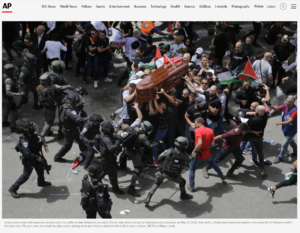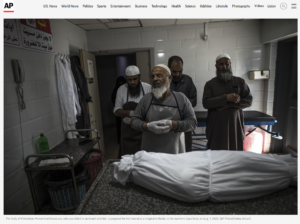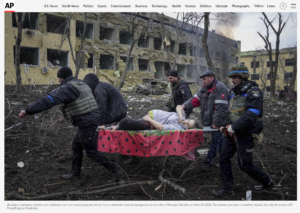Dec. 14 UPDATE:
AP Identifies Palestinian Fatality as Islamic Jihad Commander
In response to communication from CAMERA, AP has amended the caption regarding slain Palestinian Muhammad Hassouna to acknowledge the fact that he was "a senior commander in the Palestinian militant group Islamic Jihad."
"AP's top photos capture a planet bursting at the seams" is the headline for the news agency's 2022 collection of 150 powerful world images depicting war, natural disasters, triumphs and quiet moments of beauty. "A year’s worth of news images can also be clarifying," the accompanying text explains.
AP's photo essay is clarifying indeed. It throws into sharp relief the news agency's abiding, vastly disproportionate and overwhelming obsession with Israel.
The news agency's all-consuming fixation apparently fuels the editorial decision to place an outsized spotlight on the Jewish state, overshadowing the year's biggest news — the Russian invasion of Ukraine, which has so far claimed well over 200,000 lives. In the same time period, the Israel-Palestinian conflict has claimed less than 200 lives, representing about one tenth of one percent of the Ukraine-Russia body count.
And of course the Ukrainian war has seismic implications well beyond Europe: reigniting fears of nuclear war and exacerbating food supply chain issues and world hunger.
Nevertheless, the image that AP chose to highlight at the very top of its photographic essay capturing 2022 in all of its horror and glory had nothing to do with that devastating war. It's not for lack of choices. The photo essay includes more than 20 images of the Russia-Ukraine conflict, including the iconic photograph of a wounded, heavily pregnant woman being carried out of the Mariupol hospital destroyed in a Russian bombing raid shortly after the war began. While the mother-to-be and her unborn child did not survive, the enduring image of her harrowing escape from the hospital has been seared into the world's consciousness, assuming a permanent place in our collective archive of war images.
The AP, though, passed over that haunting image as the featured photograph. The news agency also skipped over all of the other moving photographs capturing the daily struggles of Ukraine's population living and dying under siege.
It's not that the news agency chose to shy away from conflict, opting for a more soothing scene of natural beauty, human accomplishment or normal daily life.
Far from it. AP did elect to put the spotlight on strife — just not the strife with the highest death count and the highest stakes for all of humanity.

The photograph of clashing Israeli police and Palestinians at Shireen Abu Akleh's funeral, featured at the very top of AP's 2022 photo essay
Instead, AP editors elected to reserve the essay's most visible spot for a photograph depicting Palestinians clashing with Israeli police at the Jerusalem funeral of Palestinian journalist Shireen Abu Akleh. Killed in disputed circumstances in the middle of a gun battle during an arrest raid, Abu Akleh was reportedly one of 67 journalists who died in the line of duty. (While being a war correspondent is indeed risky affair, covering major international sporting events should be less so. Nevertheless, renowned American sports reporter Grant Wahl dropped dead last week in the middle of reporting at the World Cup in Qatar. Grant's brother charges foul play, noting that the homophobic Qatari regime detained the reporter for half an hour two weeks ago because he wore a pride shirt.)
AP's unhealthy obsession with Israel manifests itself beyond the selection of the featured photograph. It also crowded out any images of Iran, where the Islamic regime has reportedly killed some 500 of its own citizens since protests broke out in September, riveting international attention. Iran's internal turbulence, posing a challenge to the regime's stability, is not merely of domestic concern. A nuclear power which has stymied international efforts to come to an agreement reining in its nuclear program, Iran's meddling in international strife extends beyond Middle Eastern conflicts (with its support for and arming of Hezbollah in Lebanon, its involvement in the war in Yemen, and its attacks on Israeli and Western affiliated ships in the Persian Gulf). Iran has also inserted itself into the Ukrainian conflict, providing Russia with drones in exchange for military support.
Yet, AP's collection of 150 images includes not a single photograph relating to Iran, despite international protests around the world in support of the Iranian demonstrators. The Iranian protests gained more international exposure thanks to the World Cup in Qatar, when the Iranian team initially refused to sing the national anthem and supporters of the regime harassed anti-regime protesters, ripping away their flags and banners.
Political issues are erupting fast and furious in Qatar on a near-daily basis. Soccer is at times a reflection of the entire planet. Outside the World Cup bubble, the world has also kept turning with several fractious events. Analysis by @TamerFakahany. https://t.co/msoSKqZR4X
— The Associated Press (@AP) November 29, 2022
The FIFA games in Qatar, and the surrounding political rumblings which garnered international attention, were another casualty of the AP photo department's singular Israel obsession. Not a single Qatar or World Cup-related photo made it into AP's 2022 photo collection despite the massive global fascination with one of the most popular sporting events in the world. Besides the newsworthy Iran-related images coming out of the tournament, fans world-wide may recall the memorable Associated Press photograph of the German starting team covering their mouths in protest of Qatar's refusal to allow them to sport the "One Love" armband meant to draw attention to the host's abysmal human rights record.
"As history in 2022 unfolded and the world lurched forward — or, it seemed sometimes, in other directions — Associated Press photographers were there to bring back unforgettable images," national writer Ted Anthony wrote in the introduction to the essay. Perhaps. But in the news agency's own collection of top 2022 images, some of these "unforgettable images" of significant world events which captured our collective attention were dropped wholesale.
The specific content of the photographs depicting Israel and the Palestinians — those scenes which disproportionately populated the gallery — is also revealing. Of the nine images, seven depict Palestinians as victims and Israelis as aggressor or oppressors. The remainder are both unrelated to the conflict -- a daily life image of a Tel Aviv park scene and a photograph of dead cranes stricken by the bird flu in the Hula Valley.
The AP's inclination to shoehorn the Israeli-Palestinian conflict into a predetermined narrative in which the former are necessarily the aggressors and the latter are the victims is epitomized by a caption which erases a Palestinian Islamic Jihad commander's affiliation with the terror organization. The caption about the slain terror commander depicts him as nothing more than another killed Palestinian. Completely omitting any mention of his status as a top figure in the terror organization, the incomplete caption states: "The body of Palestinian Muhammad Hassouna, who was killed in an Israeli airstrike, is prepared for his funeral at a hospital in Rafah, in the southern Gaza Strip, on Aug. 7, 2022. (AP Photo/Fatima Shbair)."
 It's not that AP didn't know that Hassouna was a commander in a designated terror organization. AP's original caption, published at the time of his death, appropriately did include the essential information that Hassouna was an Islamic Jihad commander. It stated:
It's not that AP didn't know that Hassouna was a commander in a designated terror organization. AP's original caption, published at the time of his death, appropriately did include the essential information that Hassouna was an Islamic Jihad commander. It stated:
The body of Palestinian Muhammad Hassouna, who was killed in an Israeli airstrike is prepared for his funeral at a hospital in Rafah, in the southern Gaza Strip, Sunday, Aug. 7, 2022. An Israeli airstrike in Rafah killed a senior commander in the Palestinian militant group Islamic Jihad, authorities said Sunday, its second leader to be slain amid an escalating cross-border conflict. (AP Photo/Fatima Shbair)

